Oldsmobile Cutlass
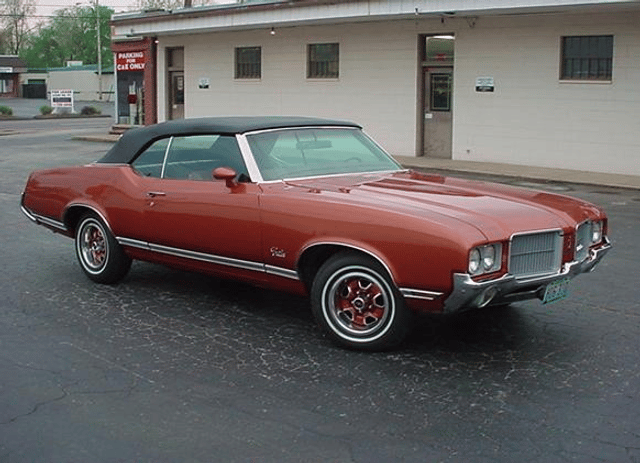
Oldsmobile Cutlass

| Oldsmobile Cutlass | |
|---|---|
| Overview | |
| Manufacturer | General Motors |
| Production | 1961–1999 |
| Assembly | Lansing Car Assembly Lansing, Michigan |
| Body and chassis | |
| Class | Compact (1961–1963) Mid-size (1964–1981, 1997–1999) Personal luxury car (1968-1988) |
| Chronology | |
| Predecessor | Oldsmobile Cutlass Ciera (for 1997) |
| Successor | Oldsmobile Cutlass Ciera (for 1982) Oldsmobile Alero (for 1999) |
| First generation | |
 1961 F-85 De Luxe Station Wagon | |
| Overview | |
| Also called | Oldsmobile F-85 |
| Production | 1961–1963 |
| Assembly | South Gate Assembly South Gate, California Lansing Car Assembly Lansing, Michigan Lakewood Assembly Lakewood Heights, Georgia |
| Body and chassis | |
| Body style |
|
| Layout | Front-engine, rear-wheel-drive |
| Platform | Y-body |
| Powertrain | |
| Engine | 215 cu in (3.5 L) Rockette V8 215 cu in (3.5 L) Turbo-Rocket turbocharged V8 |
| Transmission |
|
| Dimensions | |
| Wheelbase | 112 in (2,845 mm)[1] |
| Length | 1961–62: 188.2 in (4,780 mm) 1963: 192.2 in (4,882 mm) |
| Width | 1961–62: 71.6 in (1,819 mm) 1963: 73.7 in (1,872 mm) |
| Second generation | |
 1964 Oldsmobile F-85 four-door sedan | |
| Overview | |
| Also called | Oldsmobile F-85 Oldsmobile F-85 Cutlass Oldsmobile 4-4-2 |
| Production | 1964–1967 |
| Body and chassis | |
| Body style | 4-door sedan 4-door hardtop 2-door coupe 2-door hardtop 2-door convertible 4-door station wagon |
| Layout | Front-engine, rear-wheel-drive |
| Platform | A-body |
| Related | Oldsmobile Vista Cruiser |
| Powertrain | |
| Engine | 225 cu in (3.7 L) V6 155 hp 250 cu in (4.1 L) Chevrolet I6 155 hp 330 cu in (5.4 L) V8 230-310 hp 400 cu in (6.6 L) V8 345 hp |
| Transmission | 2-speed automatic 3-speed manual |
| Dimensions | |
| Wheelbase | 115 in (2,900 mm) |
| Length | 1964: 203 in (5,200 mm) 1965–67: 204.3 in (5,190 mm) |
| Curb weight | 3,440 lb (1,560 kg) |
| Third generation | |
 1968 Oldsmobile Cutlass Station Wagon | |
| Overview | |
| Also called |
|
| Production | 1968–1972 |
| Body and chassis | |
| Body style |
|
| Layout | Front-engine, rear-wheel-drive |
| Platform | A-body |
| Related | Acadian Beaumont Chevrolet Chevelle Chevrolet Monte Carlo Chevrolet Malibu Chevrolet El Camino GMC Sprint Pontiac Tempest Pontiac LeMans Pontiac Grand Prix Pontiac GTO Oldsmobile F-85 Oldsmobile 442 Oldsmobile Hurst/Olds Buick Special Buick Skylark Buick GSX |
| Powertrain | |
| Engine | 250 cu in (4.1 L) Chevrolet I6 350 cu in (5.7 L) V8 400 cu in (6.6 L) V8 455 cu in (7.5 L) V8 |
| Dimensions | |
| Wheelbase | 112 in (2,845 mm) 2-door coupe, hardtop and convertible 116 in (2,946 mm) 4-door sedan and station wagon[6] |
| Length | 201.9 in (5,128 mm) 2-door coupe, hardtop and convertible 205.9 in (5,230 mm) 4-door sedan 212.6 in (5,400 mm) station wagon |
| Width | 76.2 in (1,935 mm) 2-door coupe, hardtop and convertible 76.8 in (1,951 mm) 4-door sedan and station wagon |
| Curb weight | 3,515 lb (1,594 kg) |
| Fourth generation | |
 1974 Oldsmobile Cutlass Colonnade Hardtop Coupe | |
| Overview | |
| Also called | Cutlass S Oldsmobile Cutlass Supreme Oldsmobile Cutlass Salon Oldsmobile 4-4-2 Oldsmobile Cutlass Cruiser Oldsmobile Vista Cruiser |
| Production | 1973–1977 |
| Assembly | Lansing, Michigan Arlington, Texas Doraville, Georgia Framingham, Massachusetts |
| Designer | Tom Matano (1976)[10] |
| Body and chassis | |
| Body style | 4-door sedan 5-door station wagon 2-door coupe |
| Layout | Front-engine, rear-wheel-drive |
| Platform | A-body |
| Powertrain | |
| Engine | 231 cu in (3.8 L) Buick V6 250 cu in (4.1 L) Chevrolet I6 260 cu in (4.3 L) V8 350 cu in (5.7 L) V8 403 cu in (6.6 L) V8 455 cu in (7.5 L) V8 |
| Transmission | 5-speed manual 4-speed manual 3-speed manual 3-speed automatic |
| Dimensions | |
| Wheelbase | 112 in (2,800 mm) (coupe).[11] 116 in (2,900 mm) (sedan) |
| Length | 207"[11] |
| Width | 76.5"[11] |
| Fifth generation | |
 1979 Cutlass Salon fastback | |
| Overview | |
| Also called | Oldsmobile Cutlass Supreme (1978–1988) Oldsmobile Cutlass Calais (1978–1984) Oldsmobile Cutlass Salon (1985–1987) Oldsmobile Cutlass Cruiser (1978–1983) Oldsmobile 4-4-2 (1978–1980, 1985-1987) |
| Production | 1978–1988 |
| Assembly | Arlington, Texas Doraville, Georgia Framingham, Massachusetts Lansing, Michigan Sainte-Thérèse, Quebec, Canada |
| Body and chassis | |
| Body style | 4-door sedan 4-door fastback sedan 5-door station wagon 2-door coupe 2-door fastback coupe |
| Layout | Front-engine, rear-wheel-drive |
| Platform | A-body (1978–81) G-body (1982–88) |
| Related | Buick Century Chevrolet El Camino Chevrolet Malibu Chevrolet Monte Carlo Pontiac Grand Am Pontiac Grand Prix Pontiac Le Mans |
| Powertrain | |
| Engine | |
| Dimensions | |
| Wheelbase | 108 in (2,700 mm) |
| Chronology | |
| Successor | Oldsmobile Cutlass Ciera |
The Oldsmobile Cutlass was a range of automobiles produced by General Motors' Oldsmobile division between 1961 and 1999. At its introduction, the Cutlass was Oldsmobile's smallest model; it began as a unibody compact car, but saw its greatest success as a body-on-frame intermediate.
Introduced as the top trim level in Oldsmobile's compact F-85 line, the Cutlass evolved into a distinct series of its own, spawning numerous variants, including the formidable 4-4-2 muscle car in 1964, premium Cutlass Supreme in 1966, and outright performance Hurst/Olds in 1968, as well as the Vista Cruiser station wagon.
By the 1980s, Oldsmobile was using the Cutlass as a sub-marque, with numerous vehicle lines bearing the name simultaneously. These included the Cutlass Calais compact, the midsize Cutlass Ciera, the Cutlass Cruiser station wagon, and top of the line midsize Cutlass Supreme.
| Oldsmobile Cutlass | |
|---|---|
| Overview | |
| Manufacturer | General Motors |
| Production | 1961–1999 |
| Assembly | Lansing Car Assembly Lansing, Michigan |
| Body and chassis | |
| Class | Compact (1961–1963) Mid-size (1964–1981, 1997–1999) Personal luxury car (1968-1988) |
| Chronology | |
| Predecessor | Oldsmobile Cutlass Ciera (for 1997) |
| Successor | Oldsmobile Cutlass Ciera (for 1982) Oldsmobile Alero (for 1999) |
| First generation | |
 1961 F-85 De Luxe Station Wagon | |
| Overview | |
| Also called | Oldsmobile F-85 |
| Production | 1961–1963 |
| Assembly | South Gate Assembly South Gate, California Lansing Car Assembly Lansing, Michigan Lakewood Assembly Lakewood Heights, Georgia |
| Body and chassis | |
| Body style |
|
| Layout | Front-engine, rear-wheel-drive |
| Platform | Y-body |
| Powertrain | |
| Engine | 215 cu in (3.5 L) Rockette V8 215 cu in (3.5 L) Turbo-Rocket turbocharged V8 |
| Transmission |
|
| Dimensions | |
| Wheelbase | 112 in (2,845 mm)[1] |
| Length | 1961–62: 188.2 in (4,780 mm) 1963: 192.2 in (4,882 mm) |
| Width | 1961–62: 71.6 in (1,819 mm) 1963: 73.7 in (1,872 mm) |
| Second generation | |
 1964 Oldsmobile F-85 four-door sedan | |
| Overview | |
| Also called | Oldsmobile F-85 Oldsmobile F-85 Cutlass Oldsmobile 4-4-2 |
| Production | 1964–1967 |
| Body and chassis | |
| Body style | 4-door sedan 4-door hardtop 2-door coupe 2-door hardtop 2-door convertible 4-door station wagon |
| Layout | Front-engine, rear-wheel-drive |
| Platform | A-body |
| Related | Oldsmobile Vista Cruiser |
| Powertrain | |
| Engine | 225 cu in (3.7 L) V6 155 hp 250 cu in (4.1 L) Chevrolet I6 155 hp 330 cu in (5.4 L) V8 230-310 hp 400 cu in (6.6 L) V8 345 hp |
| Transmission | 2-speed automatic 3-speed manual |
| Dimensions | |
| Wheelbase | 115 in (2,900 mm) |
| Length | 1964: 203 in (5,200 mm) 1965–67: 204.3 in (5,190 mm) |
| Curb weight | 3,440 lb (1,560 kg) |
| Third generation | |
 1968 Oldsmobile Cutlass Station Wagon | |
| Overview | |
| Also called |
|
| Production | 1968–1972 |
| Body and chassis | |
| Body style |
|
| Layout | Front-engine, rear-wheel-drive |
| Platform | A-body |
| Related | Acadian Beaumont Chevrolet Chevelle Chevrolet Monte Carlo Chevrolet Malibu Chevrolet El Camino GMC Sprint Pontiac Tempest Pontiac LeMans Pontiac Grand Prix Pontiac GTO Oldsmobile F-85 Oldsmobile 442 Oldsmobile Hurst/Olds Buick Special Buick Skylark Buick GSX |
| Powertrain | |
| Engine | 250 cu in (4.1 L) Chevrolet I6 350 cu in (5.7 L) V8 400 cu in (6.6 L) V8 455 cu in (7.5 L) V8 |
| Dimensions | |
| Wheelbase | 112 in (2,845 mm) 2-door coupe, hardtop and convertible 116 in (2,946 mm) 4-door sedan and station wagon[6] |
| Length | 201.9 in (5,128 mm) 2-door coupe, hardtop and convertible 205.9 in (5,230 mm) 4-door sedan 212.6 in (5,400 mm) station wagon |
| Width | 76.2 in (1,935 mm) 2-door coupe, hardtop and convertible 76.8 in (1,951 mm) 4-door sedan and station wagon |
| Curb weight | 3,515 lb (1,594 kg) |
| Fourth generation | |
 1974 Oldsmobile Cutlass Colonnade Hardtop Coupe | |
| Overview | |
| Also called | Cutlass S Oldsmobile Cutlass Supreme Oldsmobile Cutlass Salon Oldsmobile 4-4-2 Oldsmobile Cutlass Cruiser Oldsmobile Vista Cruiser |
| Production | 1973–1977 |
| Assembly | Lansing, Michigan Arlington, Texas Doraville, Georgia Framingham, Massachusetts |
| Designer | Tom Matano (1976)[10] |
| Body and chassis | |
| Body style | 4-door sedan 5-door station wagon 2-door coupe |
| Layout | Front-engine, rear-wheel-drive |
| Platform | A-body |
| Powertrain | |
| Engine | 231 cu in (3.8 L) Buick V6 250 cu in (4.1 L) Chevrolet I6 260 cu in (4.3 L) V8 350 cu in (5.7 L) V8 403 cu in (6.6 L) V8 455 cu in (7.5 L) V8 |
| Transmission | 5-speed manual 4-speed manual 3-speed manual 3-speed automatic |
| Dimensions | |
| Wheelbase | 112 in (2,800 mm) (coupe).[11] 116 in (2,900 mm) (sedan) |
| Length | 207"[11] |
| Width | 76.5"[11] |
| Fifth generation | |
 1979 Cutlass Salon fastback | |
| Overview | |
| Also called | Oldsmobile Cutlass Supreme (1978–1988) Oldsmobile Cutlass Calais (1978–1984) Oldsmobile Cutlass Salon (1985–1987) Oldsmobile Cutlass Cruiser (1978–1983) Oldsmobile 4-4-2 (1978–1980, 1985-1987) |
| Production | 1978–1988 |
| Assembly | Arlington, Texas Doraville, Georgia Framingham, Massachusetts Lansing, Michigan Sainte-Thérèse, Quebec, Canada |
| Body and chassis | |
| Body style | 4-door sedan 4-door fastback sedan 5-door station wagon 2-door coupe 2-door fastback coupe |
| Layout | Front-engine, rear-wheel-drive |
| Platform | A-body (1978–81) G-body (1982–88) |
| Related | Buick Century Chevrolet El Camino Chevrolet Malibu Chevrolet Monte Carlo Pontiac Grand Am Pontiac Grand Prix Pontiac Le Mans |
| Powertrain | |
| Engine | |
| Dimensions | |
| Wheelbase | 108 in (2,700 mm) |
| Chronology | |
| Successor | Oldsmobile Cutlass Ciera |
Origins
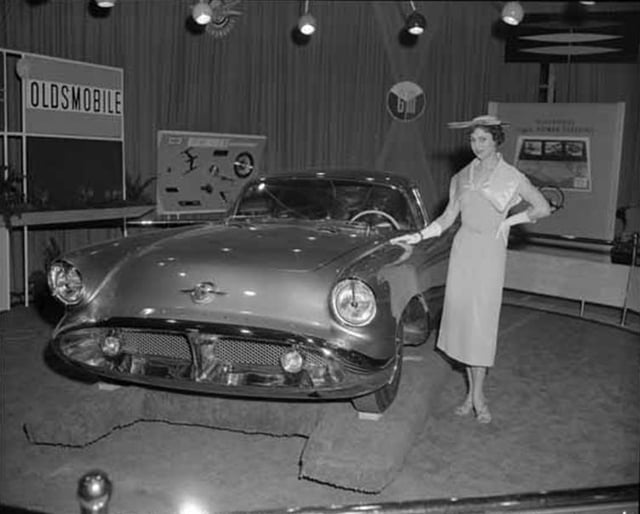
The 1954 Oldsmobile Cutlass on display at the 1955 General Motors Motorama
Oldsmobile first used the Cutlass name on an experimental sports coupe designed in 1954. It rode a 110 in (2,800 mm) wheelbase, and featured a dramatic fastback roofline and stock V8. Its platform was similar to the compact F-85 introduced seven years later.
First-generation (compact) 1961–1963
General Motors began developing its first compact cars in 1956, beginning with initial planning on what would become the Chevrolet Corvair in 1960. The following year a second series of somewhat larger cars was planned for Buick, Oldsmobile, and Pontiac; what would be termed "senior compacts". They would share the same body shell and lightweight engine. Oldsmobile designer Irvin Rybicki began work on the Olds model in 1957. It finally went on sale in 1960 as a 1961 model.
The Oldsmobile F-85 shared a new Y-body platform with the Buick Special and Pontiac Tempest, using a 112-inch (2845 mm) wheelbase and still-novel unibody construction. It was Oldsmobile's smallest, cheapest model—some two feet (60 cm) shorter and $451 less than the next-smallest Olds, the full-sized Dynamic 88. The F-85 had double wishbone front suspension and a four-link live axle in the rear, suspended with coil springs all around; the drum brakes had a diameter of 9.5 inches (240 mm). Unlike its platform mates, the first-generation F-85 was only ever offered with a V8 engine. Standard engine was the new Rockette 215 cu in (3.5 l) all-aluminum V8, Oldsmobile's version of the Buick aluminum V8 which later became famous as the Rover V8. With a two-barrel carburetor and an 8.75:1 compression ratio, it was rated 155 brake horsepower (116 kW; 157 PS) at 4,800 rpm and 210 lb⋅ft (285 N⋅m) at 3,200 rpm.[2] Specifications for the base engine remained the same throughout the 1961–1963 production run.
1961
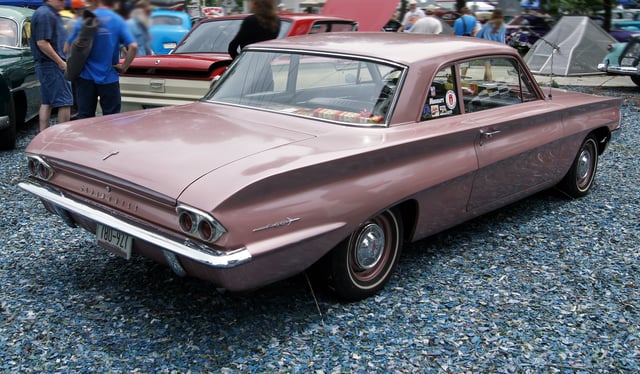
Rear view of a 1962 Oldsmobile F-85 Club Coupe
The first-year F-85 was offered in two body styles, a four-door sedan or a four-door station wagon with either two or three seats, and in a choice of two trim levels, base or De Luxe. Transmission options were initially a 3-speed manual (with synchromesh on the top two gears)[3] and the newly introduced 3-speed Roto Hydramatic. Overall length was 188.2 inches (4,780 mm), and curb weight was around 2,800 pounds (1,300 kg). A few months after the model introduction, Oldsmobile added a "power pack option", which included a four-barrel carbureted, high-compression (10.25:1), dual exhaust version of the 215 cu in aluminum V8, and a shorter 3.36:1 final drive ratio with either manual and automatic transmissions.[2] This premium fuel-only engine was rated at 185 horsepower (138 kW; 188 PS) at 4,800 rpm and 230 lb⋅ft (312 N⋅m) at 3,200 rpm.[4] Initial sales were somewhat disappointing, but were soon picked up by the May 1961 introduction of a pair of pillared two-door coupes, each with a different roofline and market placement: the F-85 Club Coupe, which became the lowest-priced Oldsmobile model, and the sporty F-85 Cutlass. The Cutlass came equipped with the 185 hp "power pack" drivetrain, and featured De Luxe-type exterior trim with , a more upscale interior with standard bucket seats, upholstered in two-tone vertically pleated vinyl, and an optional center console.[4] 80,347 F-85s were built in total for the 1961 model year.
Car Life magazine tested an F-85 with the standard engine and automatic transmission, and recorded a 0-60 (0–96 km/h) time of 14.5 seconds, with a top speed just over 100 miles per hour (160 km/h). They praised its construction, but found its steering too slow and its suspension too soft for enthusiastic driving.
1962
For 1962 styling changes were minor, and included a new grille, different chrome ornamentation on the bodysides and new interior trim. The existing F-85 models returned, and a convertible was added to the line-up in September, available in both standard and Cutlass versions. The automatic transmission was replaced with an upgraded 4 speed Roto 5 Hydro-Matic transmission, and an all-synchromesh four-speed manual became optional. Overall F-85 sales rose to 97,382, with the Cutlass displacing the four-door De Luxe sedan as the top-selling model.
The Oldsmobile Jetfire

1962 Oldsmobile Jetfire
The bigger news was the arrival of the Oldsmobile Jetfire, a Cutlass pillarless hardtop with a turbocharged version of the 215 V8, dubbed Turbo-Rocket. This made the 1962 Jetfire the first ever turbocharged production car, an honor it shares with the 1962 Chevrolet Corvair Monza Spyder. Equipped with a Garrett AiResearch turbocharger and a sidedraft, one-barrel, blow-through carburetor, the Turbo-Rocket engine was rated at 215 bhp (218 PS; 160 kW) at 4,600 rpm and 300 lb⋅ft (407 N⋅m) at 3,200 rpm. The Jetfire came with bucket seats and console, unique trim—two chrome fins on the hood and full-length contrast stripes on the bodysides—and a pressure/vacuum gauge mounted in the console (where it was almost hidden). Although much faster than a standard F-85, the Jetfire was criticized for having the same soft suspension as its less-powerful brothers, for its lack of a tachometer and other instruments, and for the poor shift quality of both the automatic transmission and the optional four-speed. Car and Driver tested an automatic Jetfire and obtained a 0–60 time of 9.2 seconds, with a top speed of 110 mph (176 km/h). The Jetfire's high cost (nearly $300 over a standard Cutlass hardtop) and reliability problems with its turbocharged engines limited sales to 3,765.
Ultimately the Jetfire engine was far ahead of its time. With forced induction and an already high compression ratio the Jetfire was capable of producing more torque than a naturally aspirated engine that was twice its size, significantly improving the engine's efficiency and usability in real-life driving conditions, turbo lag not being an issue at motorway speeds. But since turbo and supercharging the engine essentially means forcing the compression in the combustion chamber even higher, the Jetfire was prone to 'spark-knock' and without modern engine management systems the only way to mitigate this was to use a 50/50 mixture of methanol and distilled water.
1963
The F-85 was restyled for the 1963 model year, to a crisper, more squared off design than the one of the 1961–62 models. While the wheelbase was unchanged at 112 inches, the new sheetmetal added 4 inches (100 mm) to the F-85's rear overhang, increasing overall length to 192.2 inches (4,880 mm). The Jetfire and its turbocharged V8 returned, for what would be its final year. Three-row seating was dropped on station wagons. On automatic transmission models only, the compression ratio of the "Cutlass" engine was raised to 10.75:1, pushing output to 185 hp (188 PS; 138 kW) at 4,800 rpm and 235 lb⋅ft (319 N⋅m) at 3,200 rpm. A Delcotron alternator became standard on all models, as well as on the rest of the Oldsmobile car line.[3] Overall sales climbed again to 121,639, of which 53,492 were Cutlasses.
Second generation (intermediate) 1964–1967
Disappointing sales of the compact F-85, along with the introduction of Ford Motor Company's intermediate Fairlane in 1962, prompted GM to enlarge the senior compacts for the 1964 model year.
1964
The new intermediate F-85 now rode a conventional body-on-frame chassis with a perimeter frame which it shared with the newly-introduced "A-body" Chevrolet Chevelle, and upgraded Buick Special and Pontiac Tempest. Wheelbase grew to 115 inches (2,900 mm), overall length to 203 inches (5,200 mm), and weight by more than 300 pounds (140 kg). Both the aluminum V8 and the Roto Hydramatic were discontinued in favor of a new cast-iron small-block V8 of 330 cu in (5.4 L) displacement and an optional two-speed Jetaway automatic transmission with variable-pitch stator. Buick's 225 cu in (3.7 L) V6 was the standard engine.
The body styles of the previous model returned, and a new Vista Cruiser, a stretched-wheelbase (120 inches (3,000 mm)) version of the standard station wagon featuring a raised rear roof with tinted skylights and a fold-down, forward-facing third seat, debuted on February 4, 1964. The 4-4-2 model, derived from the BO-9 police package, was also introduced in March 1964 (costing $285.14 in 1964),[5] as an answer to the new intermediate muscle car market created by the Pontiac GTO that same year.
Sales increased to 167,002 for 1964, not counting Vista Cruisers.
1965
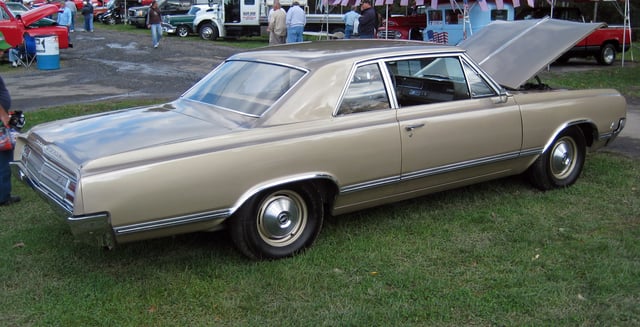
1965 Oldsmobile F-85 V6 Sports Coupe
For 1965 a modest facelift increased overall length to 204.3 inches (5,190 mm) while the front end received a "dumbbell-style" grille similar to full-sized Olds models. A bigger 400 cu in (6.6 L) engine was included with the 4-4-2 option, based on the newly introduced 425 cu in (6.9 L) engine from the full-sized Oldsmobiles while the Buick 225 V6 and Olds 330 Jetfire Rocket V8 were carried over from the previous year, with increased power ratings for the V8 options. Sales increased again to 187,097. The year 1965 was the first for Oldsmobile's "Rocket" logo that would last, with minor variations, until the 1990s.
1966
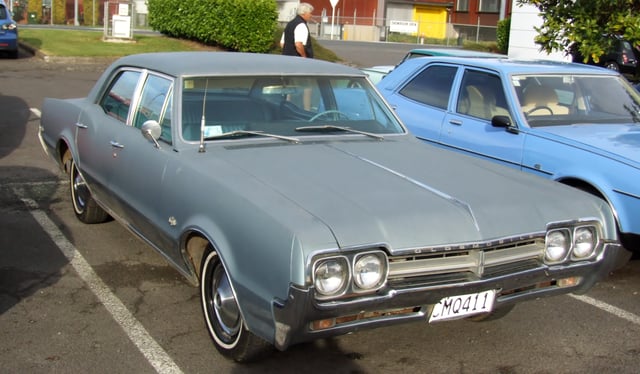
1966 Oldsmobile F-85 Deluxe four-door sedan
The 1966 models were slightly restyled again, with body lines similar to the full-sized 88, and semi-fastback rooflines with extended sail panels and tunneled rear windows on Sport (pillared) and Holiday (hardtop) coupes. The Buick V6 was replaced on base models by an Oldsmobile-badged "Action-Line 6" version of Chevrolet's 250 cu in (4.1 L) "Turbo-Thrift" straight-6 engine, while the 330 cu in (5.4 L) Jetfire Rocket V8 continued with power ratings of 250 and 320 horsepower (190 and 240 kW). New that year was the Cutlass Supreme four-door hardtop sedan also dubbed the Holiday Sedan by Oldsmobile, the first such body style for Olds' intermediate line.
1967
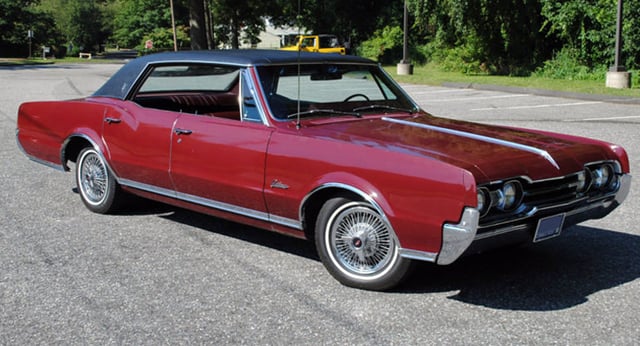
1967 Oldsmobile Cutlass Supreme Holiday Sedan
Changes for 1967 included the availability of optional disc brakes and the three-speed Turbo-Hydramatic to supplement the two-speed Jetaway. A new option was the Turnpike Cruiser package on Cutlass Supreme coupes and convertibles, which used a two-barrel carburetor and mild camshaft with the 400 cu in (6.6 L) engine and a (numerically) low axle ratio for efficient and relatively economical freeway cruising. The Turnpike Cruiser used the heavy-duty suspension of the 4-4-2, and was available only with a Turbo-Hydramatic.
Third generation (intermediate) 1968–1972
1968
The F-85/Cutlass underwent a major body restyle in 1968, as did all other GM A-body cars. Oldsmobile's was penned by the styling studio headed by Stan Wilen. Two-door and four-door models now rode different wheelbases: 112 inches (2,800 mm) for two-doors and 116 inches (2,900 mm) for four-doors. Ostensibly, this change was to allow more individual styling, although several engineers were quoted off the record as saying the 115-inch (2,900 mm) wheelbase had created problems with uncomfortable "freeway hop" owing to its resonance frequency. Overall length shrunk about 2.6 inches (66 mm), but curb weight rose approximately 75 pounds (34 kg) to 3,465 lb (1,572 kg) for the hardtop coupe. Two-door F-85 and Cutlass models adopted a semi-fastback roofline.
Base model remained the F-85, with mid-level Cutlass S, and upscale Cutlass Supreme, as well as the 4-4-2, which became a distinct model instead of an option package. A limited-production model was the Hurst/Olds, a special 4-4-2 marketed by Oldsmobile and Hurst Performance. The H/O combined the 4-4-2 suspension package with a 455 cu in (7.5 L) Rocket V8, not ordinarily offered in Cutlasses because of a GM policy limiting intermediates to engines of 400 cu in (6.6 L) or less. Cutlass and Vista Cruiser station wagons were likewise redesigned; the F-85 wagon was discontinued.
Engine options were similar to the previous year, although the Cutlass's V8 option was expanded to 350 cu in (5.7 L), still with both two- and four-barrel carburetion. The variable-pitch stator feature of both optional two-speed Jetaway and three-speed Turbo Hydra-matic automatic transmissions was discontinued.
1969
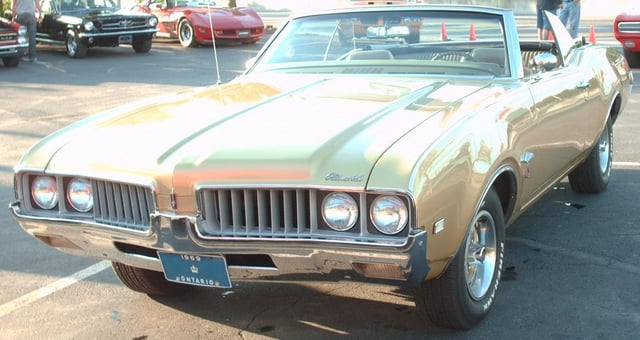
1969 Oldsmobile Cutlass S Convertible
The 1969 F-85/Cutlass models received only minor trim changes from their '68 counterparts such as a now-Olds trademark split grille with vertical bars and vertical taillights. Per federal safety regulations, headrests were now standard equipment and the ignition switch moved from the instrument panel to the steering column to lock the steering wheel when not in use, in common with all other 1969-model GM cars, one year before the locking steering columns were federally mandated.
Engine offerings were unchanged from 1968, but a new three-speed Turbo Hydra-matic 350 transmission was added to the option list and available with all versions of the 350 cu in (5.7 L) Rocket V8, including the standard two-barrel 350 cu in (5.7 L) version, four-barrel "Ultra High Compression" 310 hp (230 kW) option and the W-31 option, conservatively rated at 325 hp (242 kW).[7] The two-speed Jetaway automatic was still available with the Chevy-built 250 cu in (4.1 l) "Action-Line" six or the two-barrel 350 cu in (5.7 L) V8. The Turnpike Cruiser two-barrel 400 cu in (6.6 L) Rocket V8 was dropped and the four-barrel 400 engine from the 4-4-2 was available only in the Vista Cruiser wagons.
1970
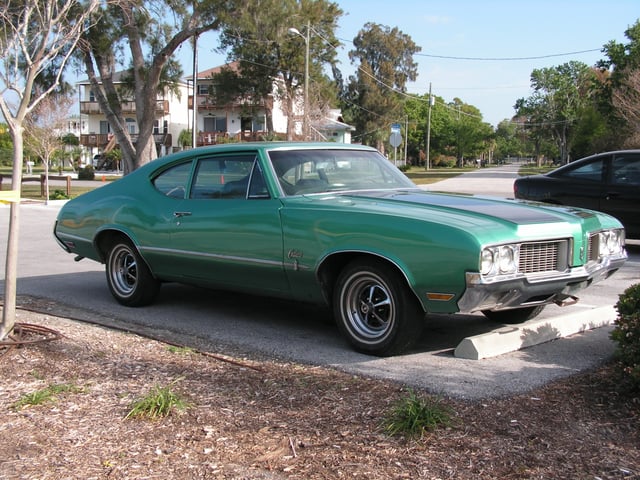
1970 Oldsmobile Cutlass S Sport Coupe

From 1970 the Cutlass Supreme Holiday Coupe wore a unique notchback roofline.
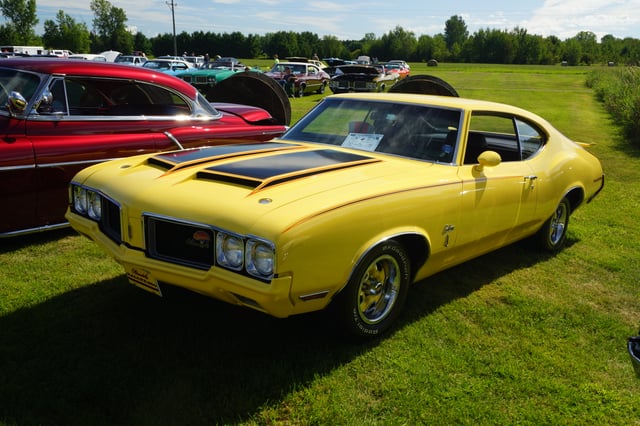
1970 Oldsmobile Rallye 350
The 1970 F-85 and Cutlass was available in seven body styles, three of which were coupes: a pillared fastback Sports Coupe (in F-85, Cutlass S or 4-4-2 trims), an hardtop fastback Holiday Coupe (Cutlass S and 4-4-2 only), and finally a more formal notchback Holiday Coupe, only offered in Cutlass Supreme trim. This practice was similar to that followed at the time by Ford and Mercury for theirintermediates, which were offered in both notchback and fastback coupes starting in 1968. Also available were a four-door hardtop Holiday Sedan, a four-door Town Sedan, a convertible, a flat-top station wagon called the Custom Cruiser, as well as the fancier Vista-Cruiser station wagon. Counting all trim level and body style permutations, Oldsmobile's 1970 lineup included 15 different intermediate models.
With GM tossing out the 400 cubic-inch limit for intermediates and the 4-4-2 now coming standard with the larger 455 cubic-inch Rocket V8 from the big Oldsmobiles and previously used in the 1968-69 Hurst/Olds, Olds discontinued the 400 engine entirely and also offered the 455 as an option in the Cutlass S models and the Vista Cruiser wagons. There was an SX option that became available in 1970 and was available only on the Cutlass Supreme hardtop and convertible. The SX cars all had the 455 engine and TH-400 automatic transmission.
The same assortment of three- and four-speed manual transmissions were carried over from previous years with Hurst shifters used on floor-mounted three-speeds and all four-speeds. The two-speed Jetaway automatic transmission was discontinued entirely with the three-speed Turbo Hydra-matic now the sole offering for shiftless driving. Cutlass S coupes with the optional Strato bucket seats and Turbo Hydra-matic could be equipped with the Hurst Dual-Gate shifter (also known as the "His and Her-Shifter") in conjunction with the extra-cost center console. The Hurst Dual-Gate made it possible to either put the transmission in Drive, and let the transmission decide when to shift. Or it could be placed in a manual mode, much like today's computer-controlled automatics.
A 1970-only offering was the Oldsmobile Rallye 350, a value-priced high-performance model using the 350 engine. It was intended for younger buyers that wanted the performance and looks of a supercar, but might have trouble with the rising insurance premiums associated with 455-engined cars like the 4-4-2.[8] In essence the Rallye 350 was an appearance package (coded W45) tied to mandatory options, and could be ordered on the Cutlass S Holiday or Sports Coupe as well as on the F-85 Sports Coupe. All Rallye 350s were painted in Sebring Yellow with matching urethane-coated bumpers front and rear. The package also included special black and orange decals, blacked out grille and yellow-painted 7" wide Super Stock II rally wheels without trim rings, wearing G70×14" bias-belted Wide Oval blackwall tires. The engine was the L74 air-inducted high-compression 350 cu.in. Rocket V8 engine, fitted with a Quadrajet carburetor and producing 310 hp (230 kW). Required options were the associated "Force-Air" fiberglass vented hood, dual exhaust with 4-4-2-style megaphone outlets, 3.23:1 axle ratio, heavy-duty "Rallye-Sport Suspension" with front and rear stabilizers, sports mirrors and sports steering wheel.
1971
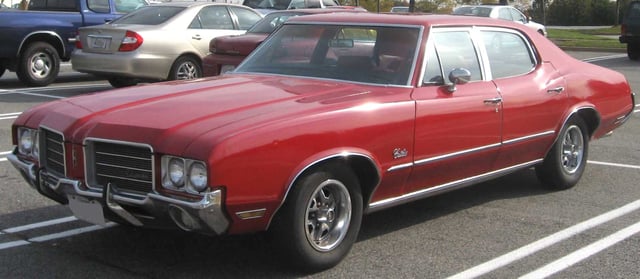
1971 Oldsmobile Cutlass Town Sedan
The 1971 model shared much of the same exterior sheetmetal as the 1970, but with a new hood, grille, and headlight assemblies, as well as new bumpers and taillights. Four new exterior body colors were offered, Viking Blue, Lime Green, Bittersweet, and Saturn Gold.
The famous "Rocket" V8 continued in several different sizes and power options, with both the large 455 and 'small-block' 350 available with either 2- or 4-barrel carburetors. This was the last year for the 250 cubic-inch six-cylinder engine, as it had not been a popular offering in Olds intermediates. All engines were now fitted with hardened valve seats, preparing for the upcoming mandate for unleaded gasoline that took effect with the introduction of catalytic converters on 1975 models. The 1971 Olds engines also featured lowered compression ratios and designed to run on regular leaded, low-lead or unleaded gasoline with a research octane rating of 91 or higher (equivalent to 87 octane by today's octane measurements).
1972
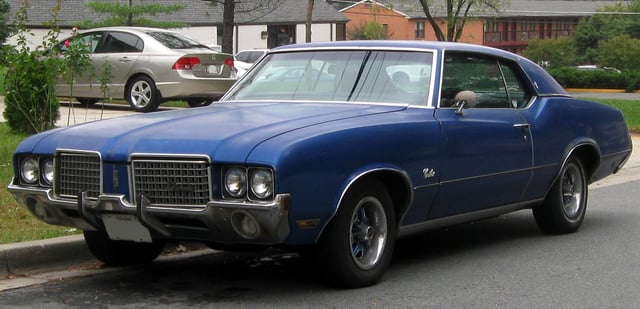
1972 Oldsmobile Cutlass hardtop
For 1972, there were minor style changes to the Cutlass, and the 4-4-2 reverted to being a trim line (W-29 option) on the Cutlass instead of an individual model, as it was in 1971.
The primary changes to the 1972 Cutlass were the front grilles and the tail lights. The straight six engine was dropped, but would return to the lineup in 1975.
The Hurst/Olds used the Cutlass Supreme notchback hardtop and convertible bodies. A 1972 Hurst/Olds paced the Indianapolis 500, and Olds built about 630 replicas, some 25% of them convertibles.[9]
The entry-level F-85 series was reduced to a single four-door sedan, and then discontinued mid-year due to low sales. This ended the use of the F-85 nameplate, although it would later resurface on an entry-level version of the compact Omega.
Fourth generation (intermediate) 1973–1977
1973
The Cutlass line was redesigned for 1973 using GM's new "Colonnade" A-body platform. While rooflines were shared with other GM divisions, Cutlass bodies now sported convex bulges aft of the front wheel and fore of the rear wheel on all body styles. The model lineup consisted of the base Cutlass, Cutlass "S", Cutlass Supreme, Cutlass Salon, Vista Cruiser station wagon, and the 4-4-2 appearance package on the Cutlass "S" colonnade coupe. The Cutlass "S" and 4-4-2 offered, as an extra-cost option, unique Strato bucket seats with high seatbacks and built-in head restraints that could be swiveled 90 degrees to permit easier entry and exit for the driver and front-seat passenger.
The new Cutlass Salon was an upscale Euro-style luxury/sports sedan similar in concept to the Pontiac Grand Am of the era. The Salon, which included items such as upgraded suspension, radial tires, reclining bucket seats and hand-operated headlamp dimmer switch (integral to the turn signal lever) was based on the Cutlass Supreme series, first as a 4-door Colonnade sedan, joined by a 2-door Colonnade hardtop coupe in 1974. The Cutlass Salon was the first Oldsmobile with the international-flags emblem, later carried on the Cutlass Ciera. Front disc brakes were standard.[11]
All Cutlass models came standard with a 180-horsepower (130 kW) 350 Rocket V8 (K code). Optionally available was a 200-horsepower (150 kW) 350 Rocket V8 with dual exhaust (M code), a 250-horsepower (190 kW) 455 Rocket V8 (U code, or L75). The top engine option was a 270-horsepower (200 kW) 455 V8, with a hotter cam and W30-style heads. This engine was called the L77 (V code), and was used primarily in four-speed cars and automatics without air conditioning in the Hurst/Olds. Transmissions included a standard column-shift three-speed manual, optional four-speed Muncie M20 manual with Hurst shifter, and three-speed Turbo-Hydramatic automatic. Upgraded gauges were optional.[11]
1974
Only minor styling changes were made on this year's Cutlass models. These included flush taillight lenses and new grilles up front, including a fascia with bumper mounted turn signals on the base model not shared with any of the other trim levels. There were newly mandated 5 mph (8.0 km/h) rear bumpers (joining the 5 mph (8.0 km/h) front bumpers mandated in '73), with a new hydraulic energy absorpotion system.[12] Both the 350 and 455 Rocket V8s were carried over unchanged from 1973 aside from revisions required to meet 1974 emission regulations. The Turbo Hydra-matic transmission became standard equipment on all Cutlass models.
1975
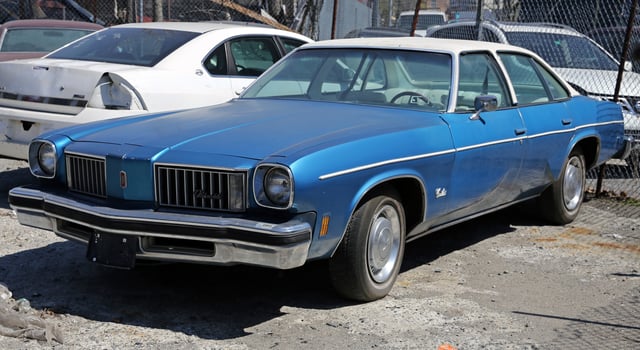
1975 Cutlass Colonnade Hardtop Sedan
For 1975, Oldsmobile added two smaller engines to attract economy-minded buyers in the aftermath of the 1973–74 energy crisis. These were the Chevrolet-built 250 cubic inches (4.1 L) inline six (previously offered from 1966–71) and a new 260 V8 based on the Olds 350 Rocket V8, which continued as an option. Also continuing was the 455 Rocket V8, rated at 190 horsepower (140 kW). All engines had catalytic converters and required unleaded gasoline in the United States; Canadian buyers could opt to delete the converter.[13] The three-speed manual transmission returned as standard equipment in conjunction with the six-cylinder engine on all Cutlass models except Salons and station wagons. However, only 0.2% of Cutlasses were built with a manual transmission as most customers overwhelmingly preferred the 350 V8 and Turbo Hydra-matic as in previous years.[14]
The '75 grilles were somewhat more angular and separated into eight pieces on each side. The parking lights were now incorporated into the grille. At the rear, new two-piece taillights were divided vertically. The S and Supreme both have a chrome strip atop the bonnet, while the Supreme also has the Oldsmobile logo mounted atop the grille. A fuel economy gauge was optional.[15]
The Cutlass line overtook the full-sized Delta 88 as the best-selling Oldsmobile line for the first time ever in 1975 with the Cutlass Supreme coupe accounting for the majority of those sales, becoming the best-selling intermediate-sized car in America by surpassing the Chevrolet Chevelle and Ford Torino for the top spot. The Cutlass was also the second-best selling car line in the U.S. in 1975, with only the full-sized Chevrolet Impala/Caprice outpacing it.
1976
The Cutlass became America's best selling car this year and would hold this title for most years into the 1980s. A restyled front end with waterfall-type split grilles and new rectangular headlights was introduced that would become an Olds Cutlass trademark in coming years, lasting into the late 1980s. Coupe bodies were reshaped for a smoother, less contoured look than the 1973-75 design, a design change shared with Buick's A-body coupes. Cutlass sedans and wagons kept their bulges through the end of model year 1977. Taillights were revised and the license plate/fuel filler was moved above the bumper. The base Cutlass line was dropped, with the Cutlass S nameplate now applied to the entry-level coupe and sedan this year - both of which featured an aerodynamic slanted front nose in contrast to the upright front ends of other Cutlass models including the Cutlass Supreme coupe, sedan and wagon, Vista Cruiser wagon, Cutlass Salon coupe and sedan, and the new Cutlass Supreme Brougham coupe. The 4-4-2 option was still offered on Cutlass S coupes as an appearance/handling package.
Engine offerings were carried over from 1975 including the Chevy-built 250 cubic-inch inline six and Olds-built Rocket V8s of 260, 350 or 455 cubic inches. A three-speed manual transmission was standard with the six-cylinder engine but Turbo Hydra-matic was optional with this engine and the 260, and required with the 350 and 455 V8s. A new option this year was a five-speed Borg-Warner manual transmission, which was available only with the 260 V8.
1977
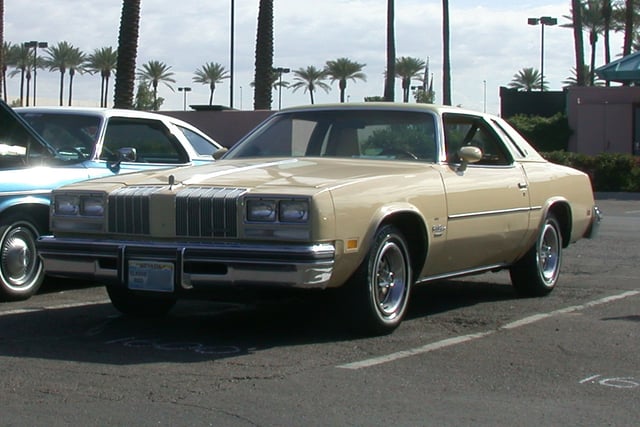
1977 Oldsmobile Cutlass Supreme Brougham Coupe
New grilles highlighted all 1977 Cutlass models with Cutlass S sedans and coupes reverting to an upright grille/front end while the more aerodynamic slanted front end was only offered with the 4-4-2 option. "Oldsmobile" nameplates in a new sans-serif typeface replaced the former script ones.
Inside was a slightly revised instrument panel with the clock relocated to the right side of the dash above the glovebox. This also marked the introduction of Oldsmobile's new mechanical digital clock. The Chevrolet inline six was replaced by Buick's 231 V6 (standard on all models except Salon and Vista Cruiser), while the 260 and 350 Rocket V8s were carried over. The big-block 455 Rocket V8 was discontinued and replaced by a new small-block 403 cubic inch Rocket V8. Transmissions included a three-speed manual (standard and only available with the V6 engine), five-speed manual (coupes with 260 V8 only) or three-speed Turbo Hydra-matic - optional on V6 models, included with the 260 V8 in sedans and 350 and 403 V8s on all models, and standard on station wagons. A sedan was added to the Supreme Brougham line, while the Salon lost its sedan version. The base wagon dropped the Cutlass Cruiser nameplate and became part of the Vista Cruiser line.
632,742 Cutlasses were built in 1977, the highest production for the model.
Fifth-generation (intermediate) 1978–1988
1978
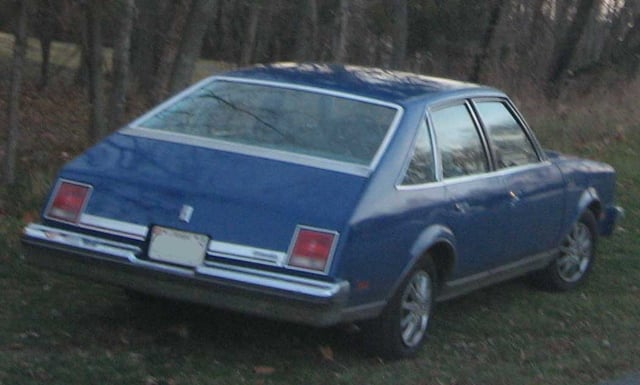
Oldsmobile Cutlass Salon
The 1978 Cutlass was downsized to the new version of GM's A-body with a shorter, 108-inch (2,743 mm) wheelbase. This Cutlass was lighter than earlier versions at around 3,300 pounds (1,500 kg), and it could be ordered with any of several engines built by GM's different divisions; a Buick 231 V6, Oldsmobile 260 V8, Pontiac 301 V8 or Chevrolet 305 V8s with either two- or four-barrel carburetors.
The '78 Cutlass lineup included the Salon and Salon Brougham fastback coupes and sedans and the formal roof Supreme, Supreme Brougham and Calais coupes. The Salons quickly proved to be far less popular than the notchback Supreme and Calais coupes. There were also "two-seat" (6 passengers in two rows) Cutlass Cruiser and Cutlass Cruiser Brougham station wagons; both being smaller, more conventional replacements of the three-seat (8 passenger) Vista Cruiser.
Broughams featured softer, quieter rides, and fancier trim and upholstery. A factory T-top was optional on notchback coupes only. The 4-4-2 appearance and handling package, available on Salon coupes, featured large lower body stripes and 4-4-2 decals outside but not always shown with decals, unique 4-4-2 seats and badges inside, and a taut performance suspension featuring quicker-ratio steering, heavier springs, stiffer shocks, a stiffer front stabilizer bar, a rear stabilizer bar, and bigger tires. The Cutlass Calais used essentially the same suspension as the 4-4-2, but it also came standard with several other performance and touring options, including full instrumentation, an aluminum spoked sport steering wheel, reclining front bucket seats and a center console with floor shifter.
Cosmetically, the 1978 line continued through 1979 with only slight changes front and rear. A bewildering array of grilles were used on the different equipment levels for 1978 and 1979, including two sets each of slotted (Salon), waterfall (Supreme incl. Brougham), and eggcrate (Calais) style designs.
1979
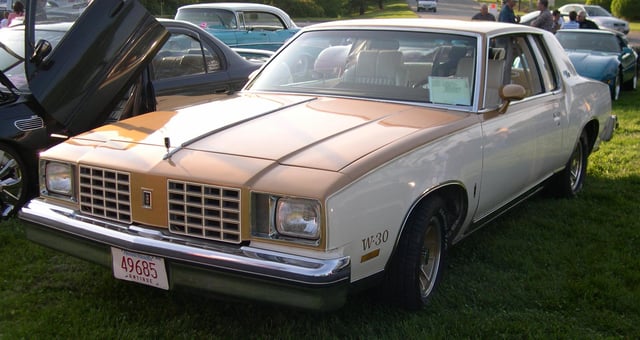
Cutlass Calais coupe with the Hurst/Olds W-30 package
The same model lineup continued, with a revision of both the front grille and taillight lenses. A diesel version of the Oldsmobile 260 (based on the Olds 350 diesel) was optional; diesel Cutlasses had the "Oldsmobile Diesel" badges on the decklids, where gasoline-powered Cutlasses had the "Rocket" logo.
Only 2499 Cutlass Calais coupes were equipped with the Hurst/Olds W-30 package, featuring unique aluminum wheels trimmed with gold paint, an exclusive console-mounted Hurst Dual Gate floor shifter, special gold over black or white two-tone paint and an otherwise unavailable Oldsmobile 350 V8 with a four-barrel carb and dual outlet exhausts. It is estimated that only 537 cars with the H/O package had T-Tops.
1980
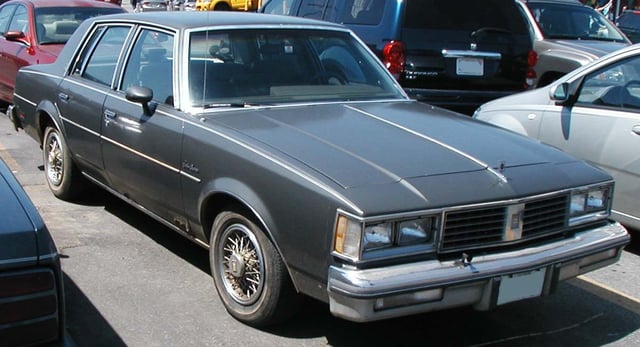
1981 Cutlass Supreme notchback sedan
Cutlass Supreme and Calais coupes received new header panels incorporating four headlights, mimicking the 1977 model. The four-door Salon was dropped due to poor sales. Taking its place was a conventional notchback sedan known simply as "Cutlass," with base, LS, and Brougham trim levels available. Sister division Buick did the same with their Buick Century sedan (the 1978 to 1980 Centuries shared the bodyshell with the Cutlass Salon). The 4-4-2 package was moved to the Cutlass Calais, and while it lacked the Dual Gate shifter, it was essentially a carryover of the 1979 Hurst/Olds, even having the Oldsmobile 350 V8 886 80 442's were produced for 1980. The 260 diesel engine was dropped, as it was considerably slower yet no more economic than the 5.7-litre diesel.[16]
1981
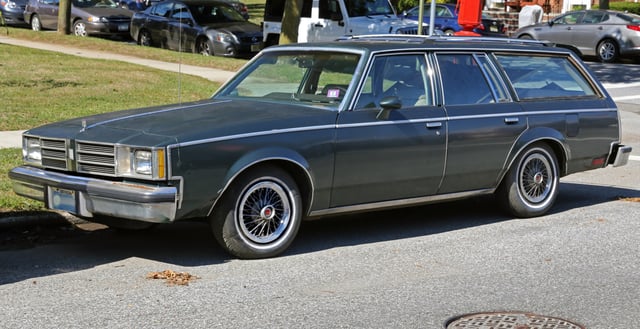
1981 Cutlass Cruiser diesel station wagon
The fastback Salon coupe was dropped, and the Supreme and Calais got a restyle that included a more aerodynamic nose and smoother body lines. Sedans got quad headlamps and a new grille. The 4-4-2 was dropped. Most of this range continued to be marketed as the Cutlass Supreme until 1986, although the Cutlass Cruiser was replaced for 1984.
Cutlass family 1982–1997
In 1982, Oldsmobile began using the Cutlass nameplate as a sub-marque, with numerous distinct vehicle lines bearing the name simultaneously.
Cutlass Ciera (1982–1996)
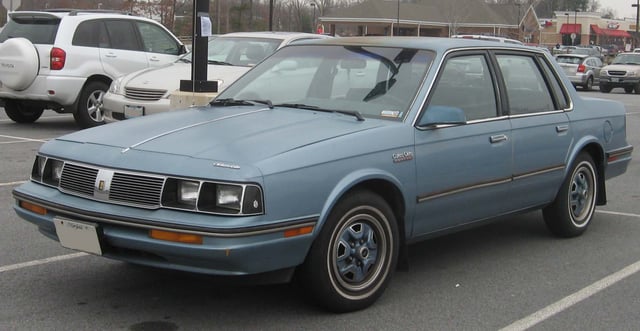
1987 Cutlass Ciera
The more space-efficient Cutlass Ciera was introduced on GM's new front-wheel drive mid-sized A platform in 1982. The Cutlass Cruiser station wagon nameplate followed the Ciera to its new platform in 1984. Coupes were produced until 1992, sedans and wagons until 1996. For the final year in production, this model was renamed simply Oldsmobile Ciera.
During its run, the Cutlass Ciera was consistently Oldsmobile's best-selling model.
Cutlass Supreme (1982–1997)
1980–1988
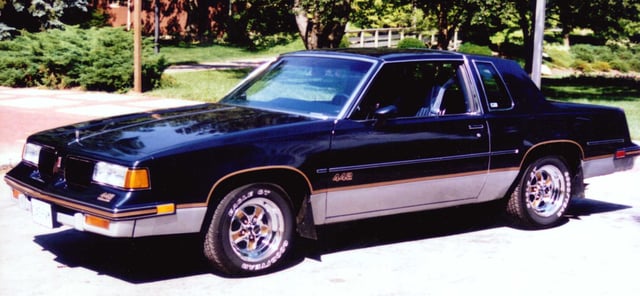
1987 Oldsmobile Cutlass Supreme 442
Meanwhile, the previous-generation Cutlass Supreme continued on the (now renamed) rear-wheel-drive G-body platform for six more years. The Hurst/Olds edition reappeared for two years in 1983 and 1984. From 1985 through 1987 the 4-4-2 replaced the Hurst/Olds as the high performance model.
Until 1984, the deluxe Cutlass Supreme model was known as the Cutlass Calais. When the Calais nameplate moved to its own platform in 1985, the top Supreme was renamed to Cutlass Salon. As the new front-wheel drive Cutlass Supreme model was being launched in 1988, the rear-drive G-special coupe remained in production for one final model year as the Cutlass Supreme Classic.
1988–1997
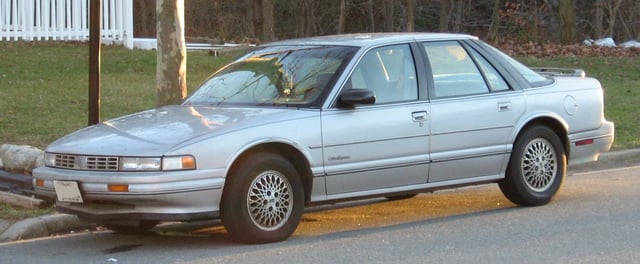
1990-91 Cutlass Supreme sedan
The premium Cutlass Supreme nameplate was moved to the new front-wheel-drive mid-sized GM W platform in 1988. Originally a coupe, a 4-door sedan model was added in 1990. Convertibles were also produced from 1990 to 1995.
In 1998, the Cutlass Supreme was replaced by the Oldsmobile Intrigue.
Cutlass Calais (1985–1991)
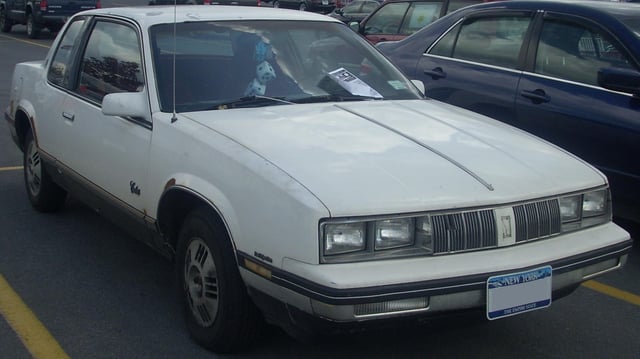
1985-86 Cutlass Calais coupe
The third Cutlass nameplate introduced was the compact Cutlass Calais (originally just Oldsmobile Calais) on the front-wheel-drive N-body in 1985. The famed 4-4-2 nameplate was revived for the Cutlass Calais in 1990 and 1991.
The Cutlass Calais was replaced by the Oldsmobile Achieva in 1992.
Sixth generation (midsize) 1997–1999

1997-1999 Oldsmobile Cutlass
The Oldsmobile Cutlass name was revived for the 1997 model year as a slightly upscale version[17] of the mechanically identical fifth generation Chevrolet Malibu.[18] The Cutlass did have a few minor differences. Visually, it had a split grille front fascia like other Oldsmobiles at the time and all red rear tail lamps.[19] Mechanically, the V6 engine was the only engine offered.[17][18] The Cutlass was available in GL and GLS trim. Available options on the base GL model included power windows, power driver's seat, power mirrors, CD player, and alloy wheels. The GLS included most of the GL's options as standard equipment plus added leather interior and was available with a power astroroof.[17] This generation of Cutlass was intended as a placeholder model to fill the gap left by the discontinuation of the Ciera, before the all-new Alero arrived.[17] Production of this generation of Cutlass ended July 2, 1999, making it the final vehicle to bear the Cutlass name.
